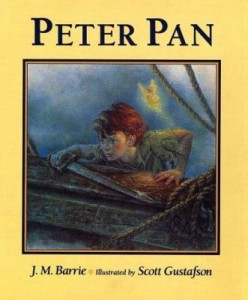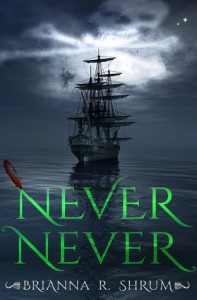 Big Ben, London, England – taken on a side trip to London during my Gilder-Lehrman Summer Teacher Seminar in 2014
Big Ben, London, England – taken on a side trip to London during my Gilder-Lehrman Summer Teacher Seminar in 2014
Recently, there has been a surge of fairy-tale retellings in YA literature, and I think it offers an excellent opportunity for students to explore the originals. I find that most of my students are familiar with the stories of Cinderella, Sleeping Beauty, Alice in Wonderland, etc. but have not read them in their original format. Instead, the students are well versed in the various cinematic adaptations, particularly those of the Disney animated variety. These modern retellings provide an opportunity for teachers and librarians to expose students to the original texts and the authors who masterminded such intricate stories that linger in our canon today.
 My Library copy of Peter Pan – it has lots of colorful illustrations, making it seem like a quick, easy read.
My Library copy of Peter Pan – it has lots of colorful illustrations, making it seem like a quick, easy read.
One of my favorites for this comparative adventure is Peter Pan by J.M. Barrie. There is literary magic in Pan’s whimsical character and his eternal youth as he is forever in the heart of a childhood adventure. However revisiting this familiar tale in its original form at an age slightly beyond Pan’s – mid to late teens, early adulthood, late adulthood – provides a different perspective on Pan’s actions. Sometimes we, as readers, lament not visiting the Neverland of our own, and other times we are shocked at Peter’s terrible behavior.
There are several retellings of Peter Pan, all adding something of their own to Barrie’s original, but today I would like to focus on a retelling from the perspective of Captain James Hook.
My favorite retelling of the Peter Pan story to date.
Everyone knows and loves the story of Peter Pan. In fact, I like to love Peter Pan himself, often forgiving the arrogance or flippancy of such a quintessential literary character. Brianna Shrum changes all of that with her beautiful exploration of the mind of Captain James Hook. He is all pirate for sure: vile, aggressive, savage. But in this version of our well known Neverland tale, he grows from boy to man; a tender man, capable of love, honor, leaving us wondering if what we have always believed about Peter is really true…
While violent and bloody (this is no Disney version) Shrum captures the essence of innocence and savagery of the young boy’s mind while also exploring what it means to become a man. Brilliant, but not for the faint of heart.
Audience: Grades 9 and Up
Curriculum Connections/Lesson Ideas:
The obvious connection is a compare and contrast discussion/graphic organizer/activity of the main characters in Shrum’s story and J. M. Barrie’s original. This might be a nice way to explore the various interpretations of the Peter Pan and Hook characters over time. Of course, there are several film and theatric versions of the Peter Pan tale which would also offer additional depth to the exploration.
Display Ideas:
Create a display matching the original tales with one (or more) modern YA retellings. Here are a few ideas to get you started – I expect most YA collections already have these tiles. It’s also worth taking a moment to make sure that the collection has a copy of the original story in a format that is engaging to the reader. The Classics are indeed timeless, but the printed editions from the 1950s are not going to encourage our modern students to spend their weekends flipping through the dusty pages.
Alice in Wonderland & Through the Looking Glass by Lewis Carroll / Splintered by A.G. Howard (a Spirit of Texas High School Author – go here for programming ideas)
“Cinderella” by Charles Perrault / Cinder by Marissa Meyer, Mechanica by Betsy Cornwell, Seeing Cinderella by Jenny Lundquist
“Snow White” by the Grimm Brothers / Stitching Snow by R.C. Lewis, Dark Shimmer by Donna Jo Napoli, Nameless: A Tale of Beauty and Madness by Lili St. Crow, Mirrored by Alex Flinn
“Sleeping Beauty” by Charles Perrault / A Wicked Thing by Rhiannon Thomas
“Rapunzel” by the Grimm Brothers / Rapunzel by Paul O. Zelinsky, Grounded: The Adventures of Rapunzel by Megan Morrison, Cress by Marissa Meyer

